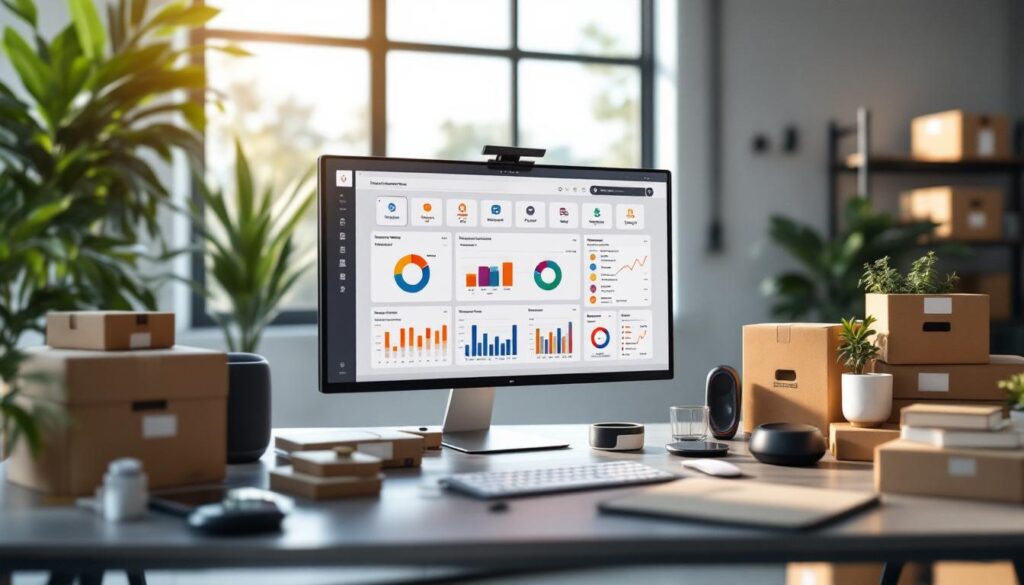Staying on top of your products is the backbone of any strong online business. If you run an ecommerce store, having reliable Ecommerce Inventory Management Software can make the difference between happy customers and missed sales. Solid inventory management means less money tied up in overstock, lower chance of running out of popular items, and fewer headaches for your team.
The right software lets you keep your shelves organized and your orders flowing. In this guide, you’ll see the ten best solutions made for modern online stores. From industry leaders to budget-friendly picks, every option is chosen for its ability to help you save time, cut costs, and scale up with confidence.
Leanafy IMS stands out as a top choice for businesses looking to streamline stock control and order fulfillment. You can get a closer look at its features with the E-commerce solutions by Leanafy for a better understanding of how it fits your business needs. Whether you’re starting out or ready to grow, this list will help you find the right fit for your store.
Why Ecommerce Inventory Management Software Matters
Getting your inventory under control is the secret to running a profitable online store. Too often, store owners spend late nights updating spreadsheets or chasing phantom stock. Reliable Ecommerce Inventory Management Software changes all of that, helping you make sense of every incoming and outgoing product. When you use software designed for ecommerce, you turn chaos into order and guesswork into clear data.
Prevents Overselling and Stockouts
Running out of your top-selling product or, worse, selling an item you no longer have damages your reputation. Ecommerce Inventory Management Software connects your sales channels and tracks every item in real time. This means when a customer buys the last item, it’s automatically updated everywhere. You avoid embarrassing emails to customers and lost sales.
- Syncs your inventory across stores, like your site and marketplaces.
- Flags low stock or fast-moving products before they sell out.
- Stops you from promising products you can’t deliver.
Think of it like a smart gatekeeper—never letting orders slip through cracks.
Improves Cash Flow
Money stuck in extra stock is money not working for your business. Good software helps you spot what’s sitting too long or moving too fast. With the right insights, you can:
- Order smarter, buying what’s needed when it’s needed.
- Discount slow movers before they tie up your shelves or become dead stock.
- See which products deserve more of your budget for restocking.
That’s the advantage of data-driven decisions instead of crossing your fingers.
Reduces Manual Errors and Saves Time
Updating orders by hand or juggling spreadsheets is a recipe for mistakes. One typo can cost you hundreds of dollars or upset your best customer. With modern Ecommerce Inventory Management Software:
- Orders, returns, and exchanges are updated automatically.
- You cut down on double-entry or miscounting products.
- Your team spends less time fixing issues and more time serving customers.
Automation keeps your store running smoothly, hour by hour.
Supports Growth and Multichannel Selling
As your store grows, tracking inventory by hand just doesn’t scale. Whether you’re adding new sales channels or branching out into new product lines, the right software lets you:
- Manage inventory for multiple warehouses or locations.
- Sell across platforms like Shopify, Amazon, and eBay without missing a beat.
- Expand without losing track of what you have or where it’s stored.
Ecommerce Inventory Management Software creates a single source of truth, so everyone works from the same information.
Gives You Better Insights for Smarter Decisions
Making decisions by gut feeling gets risky as your business grows. Inventory management tools do more than track products; they show you trends, peak seasons, and product performance. With clear reports, you can:
- Spot best-sellers and underperformers instantly.
- Forecast demand to prepare for busy months.
- Plan promotions or product launches with confidence.
If you’re thinking about switching to a system that offers rich analytics, it’s worth comparing various options, including exploring alternatives like QuickBooks Online alternative for inventory management.
Streamlines Order Fulfillment
Fast, accurate order fulfillment is what keeps customers coming back. When your inventory system integrates with shipping and order processing tools, you get:
- Fewer shipping errors and returns.
- Faster picking and packing in your warehouse.
- Real-time tracking so customers know exactly when to expect their orders.
Your entire operation runs like clockwork, even during the busiest months.
Leanafy IMS: A Standout Choice
Leanafy IMS goes beyond basic inventory tracking. It’s a powerful solution built for ecommerce and tailored to your needs. With Leanafy, order processing is simple, stock levels are easy to see, and every team member stays on the same page. Learn about the full range of benefits with the E-commerce solutions by Leanafy.
In short, investing in strong Ecommerce Inventory Management Software is like giving your store an engine upgrade—smoother, faster, and ready for growth.
Essential Features to Look For in Inventory Management Solutions
Any business leader knows that not all Ecommerce Inventory Management Software is created equal. Choosing the right solution shapes how easily you can scale, how quickly you fulfill orders, and even how confident your team feels tackling day-to-day tasks. Before settling on a platform, spending time researching core features is not just wise—it’s necessary.
Below, you’ll find the features that set the best systems apart, those that keep your business organized, responsive, and ready for anything.
Real-Time Inventory Tracking
Instant visibility into your inventory counts is non-negotiable. With real-time tracking, every sale and stock movement updates across all channels automatically. This keeps your numbers accurate whether products are flying off the shelves or slowly trickling out.
What does this look like in practice?
- No guesswork—your team always knows current stock counts.
- Safer selling across platforms, reducing risk of overselling.
- Immediate alerts when stock runs low.
Leanafy IMS delivers powerful tools that help your staff spend less time checking numbers and more time growing the business. See how inventory management solutions create clarity and control.
Multi-Channel Management
If you sell on your website, Amazon, Shopify, or all of the above, keeping inventory synced is crucial. Multi-channel management modules make it possible to:
- Avoid accidental overselling or duplicate orders.
- Sync sales across every marketplace automatically.
- Expand into new channels without extra hassle.
Solutions that natively support marketplace and store integrations allow your business to grow without extra manual tracking. Tools like the Shopify integration with Leanafy let you connect and automate large parts of your workflow with confidence.
Automated Reordering and Low Stock Alerts
Running out of a hot seller can ruin your sales streak. Automated reordering uses your sales and usage data to suggest or even create new purchase orders before you hit zero. Look for software that offers:
- Custom refill points for different products.
- Automatic PO creation for approved vendors.
- Alerts to remind you before it becomes urgent.
This feature keeps your shelves stocked and reduces the daily stress of inventory management.
Order Management and Fulfillment Tools
A top inventory system makes order processing straightforward. The features to look for include:
- Batch order processing for quick turnaround.
- Pick-pack-ship tools to boost fulfillment speed and accuracy.
- Real-time updates so your team always knows what’s next.
If you’re planning to work with large or high-volume orders, using advanced fulfillment technology such as 3PL software by Leanafy can transform how fast and accurately your warehouse runs.
Reporting and Analytics
Numbers tell the story of your business. Strong inventory management programs give you digestible reports so you can act fast and smart. The best systems provide:
- Visual dashboards and sales trends.
- Reports on product performance and aging inventory.
- Custom reports for tracking KPIs across channels.
Armed with these insights, you decide where to focus, knowing the data has your back.
Easy Integrations with Ecommerce Platforms
No one wants to cobble together a patchwork of tools. The best Ecommerce Inventory Management Software integrates with:
- Popular ecommerce platforms (Shopify, WooCommerce, BigCommerce).
- Marketplaces (Amazon, eBay, Walmart).
- Accounting, shipping, and CRM tools.
This makes onboarding smoother, minimizes downtime, and helps your staff avoid tech headaches.
Scalability and User Access Control
As your business grows, your software should keep up. Look for:
- Flexible user permissions (admin, warehouse staff, finance teams).
- Support for multiple warehouses or locations.
- The ability to add new features or users without outgrowing your system.
Leanafy IMS provides scalable features that suit small shops and growing enterprises alike.
Barcode Scanning and Mobile Access
Speed and accuracy matter on the warehouse floor. Barcode scanning and mobile access speed up receiving, picking, and shipping while drastically lowering the odds of error. This way:
- Teams handle stock efficiently, no matter the warehouse size.
- Managers get instant updates wherever they are.
Top-Notch Customer Support
Even the best systems need troubleshooting now and then. Prioritize platforms with:
- Responsive customer support teams.
- Helpful training resources and documentation.
- Onboarding that works for beginners and experts.
You want to solve problems fast, not lose hours waiting for help.
Strong Security and Data Backups
Sensitive data about your sales, customers, and suppliers should stay protected. The best software:
- Encrypts data and uses role-based permissions.
- Offers secure backups in case of an outage or error.
- Regularly updates to patch any possible weaknesses.
Choosing a provider with a strong track record in these areas lets you focus fully on running your business.
When you’re comparing Ecommerce Inventory Management Software, list out these essential features and check them off as you go. Investing time early on pays back tenfold once your business gains momentum. Leanafy IMS ticks these boxes, making it a standout choice for modern ecommerce shops ready to grow.
10 Best Ecommerce Inventory Management Software Solutions
Choosing the right Ecommerce Inventory Management Software is essential for online stores of any size. Each solution in this list offers a unique approach to helping businesses organize their inventory, automate tasks, and streamline their workflows. If you want easier stock control and less manual oversight, these top ten options are designed to suit a variety of ecommerce needs. Here’s a closer look at each software, including highlights that make them stand out.
Leanafy IMS: Powerful Ecommerce Inventory Management with Superior Order Automation
Leanafy IMS delivers a full suite of tools built for serious ecommerce operations. At its core, Leanafy lets you synchronize inventory levels across multiple channels, giving you real-time visibility whether you sell on one store or several platforms. Robust order automation takes over where most platforms lag. The system generates purchase orders, tracks shipments, and updates customers automatically. Barcode scanning and mobile access simplify warehouse work, while batch processing lets teams fulfill large volumes of orders with fewer mistakes.
Its integrations cover leading ecommerce platforms such as Shopify and Amazon, plus accounting and shipping tools. This makes it easy to expand without manual updates or missed sales. Leanafy scales from startups to high-volume businesses, letting you add more warehouses or new team members when growth happens.
Automation, custom reports, and advanced stock forecasting help you respond to trends faster. Security features and user controls ensure sensitive data stays protected. If your business outgrows spreadsheets or limited tools, check out E-commerce solutions by Leanafy for a powerful upgrade designed for growth.
NetSuite Inventory Management
NetSuite brings enterprise-level inventory control with precise tracking across locations, suppliers, and sales channels. It shines in complex setups, offering native integration with NetSuite ERP for a seamless order-to-cash process. NetSuite helps prevent stockouts by automating restock levels and purchase orders, while its forecasting tools use real data to predict trends.
This platform supports advanced warehouse management, barcoding, and real-time dashboards. Custom roles and granular permissions allow companies to secure data for different teams. It suits businesses seeking deep analytics, global scalability, and integration with financial processes.
Zoho Inventory
Zoho Inventory is a straightforward solution for small and midsize ecommerce businesses. Its clean dashboard tracks stock, manages sales and purchase orders, and sends low-stock alerts. Zoho keeps all of your online stores, from Shopify to Amazon, up to date by syncing quantities in real time.
It offers built-in shipping integrations, automated invoicing, and barcode generation. Cloud-based access means you can manage inventory anywhere. Zoho’s simple setup makes it a favorite for brands launching their first store or growing with new sales channels. It’s affordable and easy to use, making inventory management less of a headache.
Cin7
Cin7 stands out for brands that sell both online and offline. Its all-in-one platform connects sales, inventory, POS (point of sale), and third-party logistics. Cin7’s integrations cover over 700 channels, from ecommerce and marketplaces to accounting and shipping providers.
Features include demand planning, batch and serial tracking, easy barcode setup, and automated order routing. You can track stock across multiple locations and automate purchase orders when products run low. Its flexible setup suits retailers that need a bird’s-eye view of their entire supply chain on one screen.
Fishbowl Inventory
Fishbowl Inventory targets mid-sized companies needing powerful inventory management that syncs with QuickBooks and Xero. Its strength lies in manufacturing and warehouse environments, offering tools like work orders, parts tracking, and asset management. Fishbowl supports barcode scanning, reorder points, and multilocation tracking.
Batch and serial number tracking help manage regulated or perishable products. Robust reporting gives better visibility into what’s moving and what’s not. If manufacturing or assembly is part of your business, Fishbowl’s features give you clear control over complex inventory needs.
TradeGecko (QuickBooks Commerce)
QuickBooks Commerce, formerly TradeGecko, combines inventory management with easy sales integration for wholesale and retail. It connects seamlessly with Shopify, WooCommerce, Amazon, and Xero, while supporting B2B ecommerce storefronts.
Automated workflows simplify recurring orders, backorders, and inventory adjustments. Product bundles, kitting, and bundled pricing make it easy to update catalogs and run promotions. With mobile access and batch management, TradeGecko shines for businesses with multi-channel sales and those scaling wholesale as well as retail.
inFlow Inventory
inFlow Inventory provides a smooth, all-in-one experience for small businesses and growing brands. Its interface makes product setup, order management, and barcode scanning easy, even for beginners. inFlow manages inventory across locations, offers customizable reports, and simplifies reordering with built-in reminders.
The platform integrates with Shopify, WooCommerce, Amazon, and shipping carriers. You can create quotes, invoices, and purchase orders in just a few clicks. Batch tracking, serial numbers, and bill of materials support make it well-suited to retailers and light manufacturers looking for an intuitive solution.
DEAR Systems
DEAR Systems targets fast-growing ecommerce, wholesale, and manufacturing businesses. Its cloud-based software syncs inventory, sales, and operations while delivering in-depth analytics. DEAR covers every key feature for managing stock, pricing, purchasing, and production.
Automation is its strength: from order capture through shipping, it reduces manual entry and errors. It also provides multi-currency and multi-warehouse support, barcode scanning, and advanced integrations. For brands wanting enterprise-level features without enterprise complexity, DEAR Systems is a solid pick.
Ordoro
Ordoro helps ecommerce businesses master inventory, shipping, and dropshipping from one dashboard. It automates inventory syncing for all your sales channels and can route orders to suppliers or warehouses automatically.
Ordoro supports barcode scanning, advanced kitting, and supplier management. Built-in shipping integrations print labels, track shipments, and automate rate comparisons. For businesses running dropshipping or managing third-party products, Ordoro makes order fulfillment faster and simpler.
SkuVault
SkuVault is built for ecommerce retailers that need strong warehouse management. It connects inventory, orders, and picking with real-time updates so you avoid overselling and stockouts. SkuVault’s visual dashboards help team members see what to pick and pack next, keeping fulfillment fast and accurate.
Key features include barcode scanning, smart picking routes, restock alerts, and quality control workflows. SkuVault integrates with Amazon, eBay, Shopify, and more. It’s ideal for brands that have outgrown basic systems and want tighter control over stock, even as order volume climbs.
QuickBooks Online: Accounting-Driven Inventory Management
QuickBooks Online includes inventory tracking as part of its accounting-driven toolkit. It’s popular for small stores that want to manage basic stock and finances from a single dashboard. Built-in features let you track quantities, automate reorder alerts, and update costs as you receive items.
However, for growing brands and those needing features like multi-warehouse control, deeper integrations, and automation, it makes sense to explore QuickBooks Online alternative options. These platforms offer stronger real-time tracking, advanced stock insights, and wider ecommerce integrations for businesses aiming to scale.
Each of these top Ecommerce Inventory Management Software choices delivers unique strengths and fits. Whether you’re building out your first online store or upgrading from manual systems, there’s a perfect software to streamline your operations and boost business growth.
How to Choose the Right Ecommerce Inventory Management Software for Your Business
Selecting the perfect Ecommerce Inventory Management Software can feel overwhelming at first, but a simple approach makes it easier. Your decision doesn’t just affect inventory. It shapes the way your entire ecommerce business runs—impacting everything from shipping speed to cash flow. The best choice supports your current needs while giving you room to grow. Use these key factors as your roadmap to find the right fit.
Match Features to Your Business Size and Complexity
Start by listing your must-have inventory features. Every store runs a bit differently. A small ecommerce shop might just need basic stock tracking, while a larger brand with many SKUs and sales channels will want tools for multi-channel management, automation, and forecasting.
Ask yourself:
- Do you sell on multiple websites or marketplaces?
- Are you managing only finished goods, or raw materials, bundles, and kits?
- Do you need advanced reporting, batch tracking, or order automation?
Software like Leanafy IMS isn’t just for “the big guys.” It scales for small businesses just starting, but also includes robust features for growing operations. You can compare what matters most by checking the full Lean Inventory Management Software overview to see if it ticks your boxes.
Check Integration with Your Ecommerce Platforms
It’s important to pick a tool that connects with all your current (and future) sales platforms. Smooth integration prevents headaches, errors, and countless wasted hours.
Look for solutions compatible with:
- Shopify, WooCommerce, BigCommerce, Magento, and other store builders.
- Major marketplaces like Amazon, eBay, Etsy, Walmart.
- Shipping, accounting, and ERP tools.
A platform loaded with many integrations supports both today’s schedule and tomorrow’s plans. Leanafy IMS offers over 200 connections, letting you streamline warehouse, accounting, shipping, and more. The full list of Leanafy integrations gives you a sense of what’s possible without adding custom code or manual syncing.
Focus on Real-Time Inventory Visibility
Having instant, accurate inventory numbers provides peace of mind. It’s not just about knowing what’s in stock—it’s about catching problems before they cost sales. The best Ecommerce Inventory Management Software automatically updates stock across all your channels the moment a sale, return, or receipt happens. You reduce overselling and avoid disappointing your customers.
Keep an eye out for:
- Instant low-stock alerts.
- Central inventory dashboard for all locations.
- Easy tracking of lots, batches, or serial numbers if you need it.
With these, you react to demand, spot issues early, and stay ahead.
Factor in Scalability and Support
The right solution grows with you. If you plan to add new product lines, more staff, or extra warehouses, look for:
- Tiered pricing or flexible subscription plans.
- User controls so you can set role-based permissions.
- Access for team members who work remotely or in different locations.
Strong customer support—phone, email, live chat, or even a dedicated manager—can make the difference if something goes wrong or you need to set up new features.
Evaluate Reporting and Automation Options
Modern Ecommerce Inventory Management Software should give you clear reports showing which products are selling, which need to go on sale, and which should be reordered. Some tools also provide automatic purchase orders, rule-based stock alerts, and time-saving order processing.
Prioritize features like:
- Automated reorder triggers.
- Sales and inventory performance dashboards.
- Exportable data for deeper business review.
When you rely on good data and smart automation, you eliminate busywork and make stronger decisions every day.
Consider Total Cost and Return on Investment
Price is more than just a monthly fee. Think about costs for extra users, integrations, support, upgrades, or training. Some solutions provide all features upfront, while others charge for premium options.
Before buying, weigh:
- The value of your saved time vs. the monthly cost.
- Whether the platform reduces errors, lost stock, or missed sales.
- Long-term savings from improved efficiency.
When you factor everything in, the right inventory software pays for itself. Leanafy IMS, for instance, combines fair pricing with deep functionality—delivering a strong return for stores both small and large.
Choosing your Ecommerce Inventory Management Software comes down to understanding your business’s unique needs and where you want to go next. Rate each tool based on these factors and trust your instincts. Taking the time to get this step right sets your store up for smoother daily operations and less stress as your business grows.
Trends and Future of Inventory Management for Ecommerce
Modern ecommerce inventory management isn’t just about counting products on a shelf. It’s a field driven by technology shifts, changing buyer habits, and the need for speed and accuracy. Brands that want to thrive must pay attention to trends shaping the future and think ahead with their technology choices. Let’s break down the latest shifts and where inventory management software is headed.
Smarter Automation and AI-Driven Decision Making
Ecommerce Inventory Management Software is quickly moving beyond tracking and alerts. Advanced platforms now use artificial intelligence to forecast demand, recommend stock levels, and even automate reordering based on buying cycles. This means fewer out-of-stock notices, less money tied up in slow-movers, and smarter scaling.
- Machine learning spots trends before you do.
- AI-powered tools predict surges or slow spells for every SKU.
- Automated reordering reduces human error and frees up staff hours.
Leanafy IMS is on the front lines, using automation for smarter stock control and order routing. You don’t just react to changes—you get ahead of them.
Real-Time Data, Anywhere Access
With customers expecting instant updates, real-time inventory insights are now standard. Cloud-based platforms give everyone—warehouse teams, managers, and remote workers—immediate access to accurate counts and order statuses. No more waiting on batch updates or playing catch-up after big sale days.
These improvements also enable mobile inventory work. Teams use tablets or phones for receiving, picking, packing, and cycle counts, making every step more accurate and quick.
Multichannel and Global Selling Integration
Today’s sellers move their products across multiple websites, marketplaces, and even physical locations. The best ecommerce inventory management solutions now offer:
- Centralized views across all channels and locations.
- Automatic syncing between storefronts, warehouses, and suppliers.
- Built-in tools to handle cross-border sales and multi-currency stock values.
The push toward multichannel selling is clear: software that can’t unify your sales, shipping, and inventory data leaves you behind.
Rise of Sustainability and Lean Inventory
There’s a growing push for less waste in ecommerce. Brands now want to shrink overstock, cut spoilage, and make eco-friendly supply chain choices. Lean inventory practices use smart forecasting and data-driven planning so you stock what’s needed (and nothing more).
More solutions let you track product age, lot numbers, and expiration dates—all to help reduce dead stock and markdowns. For effective strategies to handle old or unsold inventory, see these aged inventory management techniques.
Enhanced Tracking Technology: QR Codes and Barcodes
Tech upgrades like QR codes and advanced barcode systems are making inventory tracking more precise. These technologies:
- Speed up receiving, picking, and shipping.
- Drive down errors with quick, accurate scans.
- Allow more data to be stored on each label.
QR codes, in particular, deliver deeper detail for each product and support faster warehouse operations. If you want to know whether to choose barcode or QR systems, check the full Barcode vs QR for inventory management guide.
Cloud Integration and API-Driven Workflows
Open APIs and easy integrations let Ecommerce Inventory Management Software work smoothly with your ERP, marketplace, shipping, or WMS tools. Platforms like Leanafy connect with hundreds of apps, covering everything from payments to accounting, making your operations run smoother with fewer silos.
Companies no longer need to overhaul their entire tech stack to upgrade inventory software. With today’s tools, you can add or swap features as your needs change.
Greater Focus on Transparency and Security
With more business happening online, security and transparency are bigger priorities than ever. New tools offer:
- Role-based access for team members.
- Real-time audit trails for every movement or transaction.
- Advanced encryption to protect sales and supplier data.
This transparency not only builds trust with your team and suppliers but can prevent costly mistakes.
Advanced Analytics and Predictive Reporting
Reporting isn’t just about what happened yesterday. The latest inventory management platforms offer predictive analytics that help businesses:
- Pinpoint best-selling products and slow movers.
- Forecast revenue based on current stock and sales trends.
- Identify seasonal spikes before they hit.
These insights turn inventory from a guessing game into a data-rich resource for smarter planning.
Evolution of Warehouse Technology
Warehouse Management Systems (WMS) continue to merge with inventory management for even tighter control. The top options sync real-time data, sort orders by priority, and even map out the fastest picking routes.
If you want a closer look at how the best systems combine warehouse and inventory management, the Top 10 warehouse management systems for 2025 guide is a great starting point.
Customization and User-Driven Features
No two ecommerce operations have the same needs. The future of Ecommerce Inventory Management Software brings more customization, allowing teams to tailor dashboards, automate favorite workflows, and add only the modules that fit their business. Leanafy offers robust features for inventory and warehouse teams so you can build the exact toolset you need.
The Bottom Line: Choosing Software That Grows With You
The future of ecommerce inventory management is clear—more automation, better forecasting, tighter integration, and a focus on reducing waste. The brands that adopt flexible, forward-thinking solutions like Leanafy IMS will get ahead and stay ahead as tech and shopper demands keep changing.
Conclusion
Finding the right Ecommerce Inventory Management Software shapes how smoothly your business runs and grows. With so many strong solutions available, it pays to match each option to your store’s real needs. The best tools balance automation, real-time updates, and integrations that help you keep up with orders and stock—no matter how fast things move.
If you want software that supports both today’s sales and your long-term growth, Leanafy IMS stands out for its flexibility and robust features. Its automation and user-friendly tools put you in control and help prevent costly mistakes. For those interested in deeper inventory control, see how Warehouse Management Solutions can add even more power to your setup.
Choosing with care means you can focus more on customers and planning, and less on fixing errors. Explore your top options, keep your business goals in view, and don’t hesitate to invest in a solution like Leanafy IMS that grows with you.
Ready to take your store to the next level? Share your favorite feature or challenge in the comments, or connect with us to get started with the right system for your business. Thanks for reading!
![10 Best Ecommerce Inventory Management Software Solutions [2025 Updated]](https://leanafy.com/wp-content/uploads/2025/07/best-ecommerce-inventory-management-software-2025.jpg)




